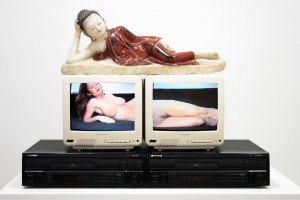« Reviews
Nam June Paik - Live Feed: 1972 -1994

Nam June Paik. Reclining Buddha, 1994. 2 color televisions, 2 Pioneer laser disk players, 2 original Paik laser disks, found object Buddha. 20” x 24” x 14”. Courtesy James Cohan Gallery, New York
James Cohan Gallery - New York
April 14 - May 30, 2009
By Janet Batet
Nam June Paik is an emblematic figure for contemporary arts. Known as one of the major exponents of the Fluxus movement and a pioneer of video art, his visionary notion about arts and technology as well as his continued exploration in the perception process -as a participative act- make him and his artistic production, a mandatory point of reference.
Born in Seoul in 1932, this South Korean-American artist centered his production on the then incipient New Media and cybernetics. In 1963, Paik starts the first manipulated TV sets experience and one year later, he becomes the first artist to make videotapes. In 1965 -more than four decades ago-, this creative thinker claimed that the television cathode-ray tube would someday replace the canvas, referring to the expansive value of this medium as entertainment.
As early as 1974, Paik appropriates McLuhan’s term global village to describe the potentiality and possibilities of the emergent New Media and introduces the today familiar concept of electronic superhighway as the inherent condition of the postindustrial society.
“Nam June Paik. Live Feed: 1972 -1994″ consists of a number of works dating from 1972 to 1994. Among them are Paik’s robot sculptures, live-feed installations and other video sculptures.
Paik’s very first robot dates from 1964. Operated by remote control, this art-machine could walk, talk, and perform. Robot K-456, has opened since then, an innovative path for experimentation in the extensive career of Paik and the contemporary art world in general.
The present exhibition includes some of the much known Paik’s robot-sculptures, among them, Beuys Voice 1990, Gertrude Stein, 1990 and Watchdog II, 1997. These first two cyborgs are splendid portraits-sculpture, a symbiosis of technology and personality. With Watchdog II, we assist a fun dissertation on traditional and modern surveillance systems. The dog made out of monitors has a surveillance camera at the end of its tail and loudspeakers for ears.
Paik was an artist and a philosopher. His passion for new technologies is just one facet of his entire cosmogony. Other vital elements feed this vast universe, among them, highlights are Buddhism and nomadism.
The notion of Buddhism is associated with categorical pairs such as meditation and velocity; the new and the traditional; mass culture and the transcendental. Enlightenment compressed and Reclining Buddha, both from 1994 and included in this exhibition, are symptomatic in this sense.
Paik’s obsession with the suppression of geographic boundaries has a parallel with his own nomadic experience. He was a traveler throughout his entire life and maybe this effort to apprehend the entire spirit of his era explains his sustained inquiry on simultaneity; inquiry that inspires all of his live-feed essential experiments.
During the last decades, Nam June Paik lived between New York and Florida. He died in his winter house in Miami Beach in January 2006.
Filed Under: Reviews


































